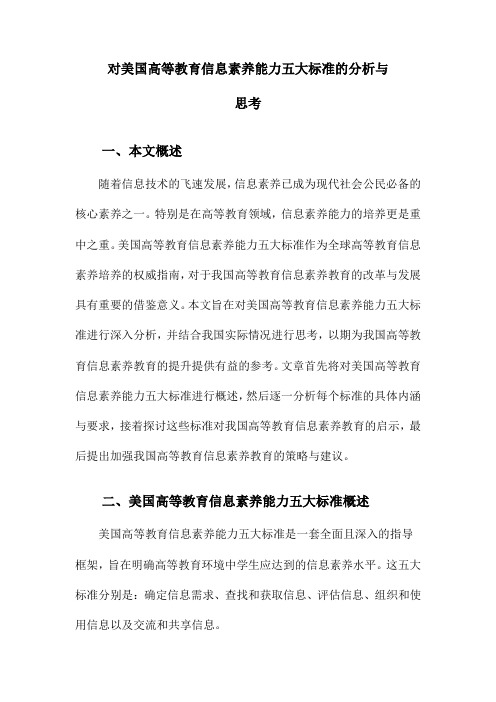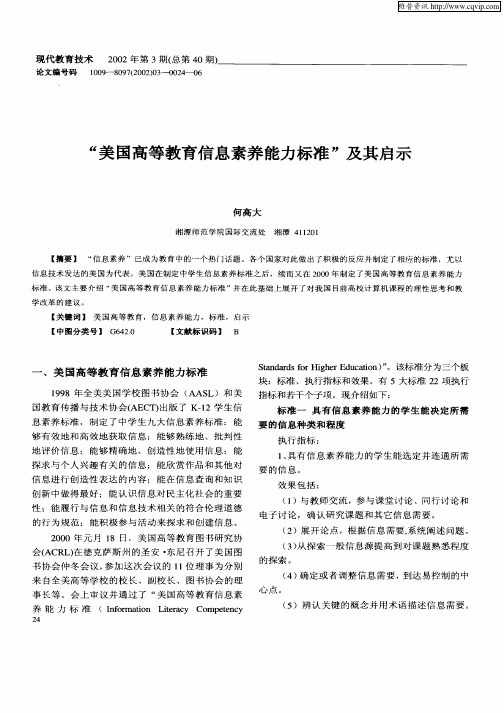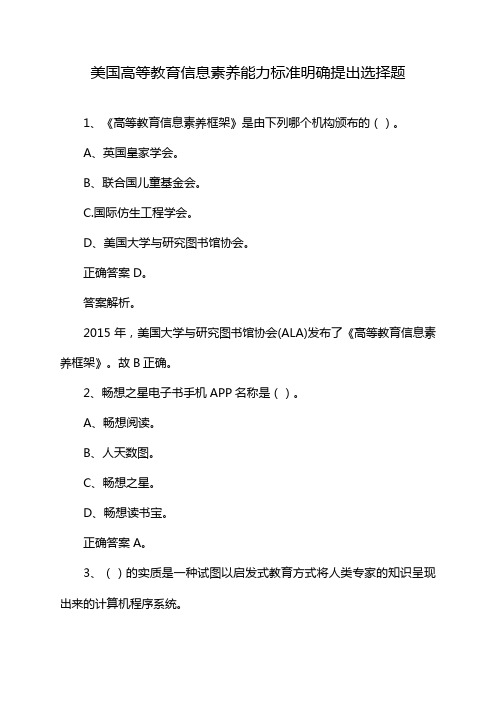美国高等教育信息素养能力标准
对美国高等教育信息素养能力五大标准的分析与思考

对美国高等教育信息素养能力五大标准的分析与思考【摘要】美国高等教育信息素养能力对于学生和教师们以及整个社会的发展至关重要。
本文从信息获取能力、信息评估能力、信息组织能力、信息交流能力和信息应用能力五个方面进行分析,探讨了这些能力在高等教育中的重要性。
信息获取能力是获取并处理信息的基础,信息评估能力是确定信息真实性和可靠性的关键,信息组织能力是将信息整理成有序的形式进行有效利用,信息交流能力是分享和传播信息的重要手段,信息应用能力是将信息应用于解决问题和创新工作中的能力。
提高这些能力将有助于学生更好地适应信息社会的发展和变化,提升整个社会的信息素养水平。
提高美国高等教育信息素养能力是必不可少的。
【关键词】美国高等教育,信息素养,能力标准,信息获取,信息评估,信息组织,信息交流,信息应用,提高素养能力,重要性。
1. 引言1.1 美国高等教育信息素养能力的重要性美国高等教育信息素养能力的重要性在当今社会变得越发显著。
随着信息化时代的到来,信息爆炸式增长,人们的获取和利用信息的方式也发生了翻天覆地的变化。
在这种情况下,高等教育信息素养的培养变得尤为重要。
信息素养能力不仅是学生获取、评估、组织、交流和应用信息的基础,更是适应社会发展和求职市场需要的必备技能。
通过培养信息素养能力,学生不仅可以更好地适应信息化社会的发展、提高个人竞争力,更能够更好地解决问题、创新思维,实现个人和社会的可持续发展。
提高美国高等教育信息素养能力是非常必要和紧迫的任务,也是促进高等教育的现代化发展和高质量教育的重要方向。
2. 正文2.1 标准一:信息获取能力的重要性信息获取是信息素养的基础,它是指在信息丰富的环境中,快速、准确地找到需要的信息。
信息获取能力对于学生在高等教育阶段的学习和研究至关重要。
信息获取能力能够帮助学生更快速地了解自己感兴趣的领域,找到相关的学术资源和资料。
通过提高信息获取能力,学生可以更有效地解决问题和开展研究,节省时间和精力。
《美国高等教育信息素养能力标准》读后感

《文献检索与利用》课程论文题目:《美国高等教育信息素养能力标准》读后感姓名:***学号: *********** 单位:第二临床医学院《美国高等教育信息素养能力标准》读后感学院:第二临床医学院姓名:郭明凯学号:20181102212 能认识到何时需要信息,和有效地搜索、评估和使用所需信息的能力,这便是信息素养。
信息素养对于信息资源高速传递和当代科技迅速发展起着极其重要的作用。
美国大学与研究图书馆协会(ACRL)在德克萨斯州的圣安·东尼,召开了美国图书协会仲冬会议,会上审议并通过了“美国高等教育信息素养能力标准”。
这一能力标准的公布,为信息素养的培养与提升提供了规范与目标,通过对“美国高等教育信息素养能力标准”的学习,提高自身信息素养能力是我们当务之急,也是提高我国文化软实力的方法之一。
感悟一:我国教育标准距美国还有一定差距同样是对高等教育学生提出的信息素养能力标准,“美国高等教育信息素养能力标准”从五大标准,二十二项执行指标对学生的能力标准做出规定:从最基本的获取信息的要求,到信息的融合、使用,最后到信息使用的合法性。
能力标准的制定是从更高的一个层面即信息社会对人才培养与发展的战略高度来认识。
美国对学生信息素养标准的理论框架是从宏观着眼,从微观着手,强调理论与实践的结合,强调公德和法律意识的培养,突出创新能力的培养,侧重于绩效的评估而不是对某些信息技术和知识的掌握,强调信息技术以人为本的方法论和创新意识,定位明确,具有较好的操作性、科学性、前瞻性和普及性,强调传统的媒体与信息技术的综合利用,可见美国对于学生的培养目标已经不是简单的使用计算机,“信息素养能力”才是核心,这也是我们值得借鉴的。
感悟二:具有信息素养能力的学生首先能够获取信息我们生活在信息多元化的时代,时时刻刻与外界进行着沟通、交流、互动,同时也在时时刻刻获取着信息,这种信息,拥有一定的信息量是我们相互交流的基础,也是我们能够互相交流的前提条件,对于研究生的我们来说,获取信息往往认为是查阅文献,其实获取信息的途径不单只有这一种,新闻媒体的报道,临床实践的积累,人与人之间的沟通都是获取信息的基本形式。
美国信息素养标准及对“计算机基础”课程的启示

美国信息素养标准及对“计算机基础”课程的启示摘?要:美国的“学生学习的信息素养标准”包括3个方面的内容、9个标准、29个指标,其“高等教育信息素养评价标准”提出了5个方面的标准内容,对世界范围内的信息素养教育均有影响。
我国的“计算机基础”课程应该借鉴美国的这两个标准来进行改革:重新定位课程名称;更新观念,改革教学内容;实现教学方法的多样化。
同时,我国还应积极展开高等教育信息素养标准的讨论。
关键词:美国信息素养标准;高等教育信息素养评价标准;“计算机基础”;启示随着信息社会的发展,信息社会所需要的人才必须具备良好的信息素养,否则,将无法适应信息社会的学习、工作、生活与竞争的需要,就会被信息社会所淘汰。
因此,应该研究信息社会所需要的信息素养的标准。
美国已制定和实施了相当数量的信息素养标准(或标准草案)。
比较成型和规范的有美国大学与图书馆协会(acrl)制定的“高等教育信息素养评价标准”、美国图书馆协会(ala)及美国教育传播与技术协会(aect)制定的“学生学习的信息素养标准”。
这些标准较完整地反映了信息素养的内涵,对信息素养教育的开展和评价具有较大的指导意义。
本文拟研究这些标准,并提出这些标准对我国信息素养教育的启示。
一、学生学习的信息素养标准1998年,美国图书馆协会(ala)和美国教育传播与技术协会(aect)制定了学生学习的九大信息素养标准。
该标准可以分为3个类别、9个标准、29个考察指标。
(一)标准内容1.第一部分:信息素养(3个标准)标准一是具有信息素养的学生能高效和有效地存取信息。
相关指标包括:认识对信息的需求;认识到准确的和综合的信息是进行智力决策的基础;基于信息需求而形成问题等。
标准二是具有信息素养的学生能批判性地和适当地评价信息。
相关指标包括:指标确定准确性、相关性和综合性;在事实、观点和意见中作出区别;确定不准确的误导的信息等。
标准三是具有信息素养的学生能准确地和创造性地使用信息。
美国高等教育信息素养能力标准观后感

英文回答:Following a review of the information literacy standards for higher education in the United States, the author is acutely aware of the importance of information literacy for contemporary university students. As a summary of students ' requirements for learning, thinking, creating and participating in the information society, the tertiary education literacy standard is both a norm for the United States higher education system and a consideration of students ' own knowledge and abilities. These standards include information awareness, information search, information evaluation, information organization, information transmission and information security, which can effectively improve students ' level of information literacy so that they are better equipped to handle information in their future studies and work and to improve learning and efficiency.在审阅了有关美国高等教育信息素养能力标准的介绍后,笔者深刻认识到信息素养对于当代大学生至关重要。
什么是信息素养

什么是信息素养(Information Literacy)“信息素养(Information Literacy)”的本质是全球信息化需要人们具备的一种基本能力。
信息素养这一概念是信息产业协会主席保罗·泽考斯基于1974年在美国提出的。
简单的定义来自1989年美国图书馆学会(American Library Association ,ALA ),它包括:能够判断什么时候需要信息,并且懂得如何去获取信息,如何去评价和有效利用所需的信息。
这样的看法目前已形成一种共识。
除美国外,一些西方发达国家的观点大同小异,ACRL提出的高校信息素养标准,在美国已被广泛认可和接收,英国、澳大利亚等根据国情,稍有补充和修改。
信息素养是一种基本能力信息素养是一种对信息社会的适应能力。
美国教育技术CEO论坛2001年第4季度报告提出21世纪的能力素质,包括基本学习技能(指读、写、算)、信息素养、创新思维能力、人际交往与合作精神、实践能力。
信息素养是其中一个方面,它涉及信息的意识、信息的能力和信息的应用。
信息素养是一种综合能力信息素养涉及各方面的知识,是一个特殊的、涵盖面很宽的能力,它包含人文的、技术的、经济的、法律的诸多因素,和许多学科有着紧密的联系。
信息技术支持信息素养,通晓信息技术强调对技术的理解、认识和使用技能。
而信息素养的重点是内容、传播、分析,包括信息检索以及评价,涉及更宽的方面。
它是一种了解、搜集、评估和利用信息的知识结构,既需要通过熟练的信息技术,也需要通过完善的调查方法、通过鉴别和推理来完成。
信息素养是一种信息能力,信息技术是它的一种工具。
1998年,美国图书馆协会和教育传播协会制定了学生学习的九大信息素养标准,概括了信息素养的具体内容。
标准一:具有信息素养的学生能够有效地和高效地获取信息。
标准二:具有信息素养的学生能够熟练地和批判地评价信息。
标准三:具有信息素养的学生能够有精确地、创造性地使用信息。
美国高等教育信息素养能力标准

美国高等教育信息素养能力标准美国高等教育信息素养能力标准美国高等教育信息素养能力标准Information Literacy Competency Standards for Higher Education美国图书馆协会(The Association of College and Research Libraries)美国大学和研究型图书馆协会(A division of the American Library Association)翻译:白健最近《关于事实检索的讨论》让我们思考什么才是检索的问题。
除了文献检索,是不是还忽略了某些东西?检索知识交流版存在的意义与宗旨又是什么?获得信息能力的培养是否比信息(文献)本身更加重要?重读《美国高等教育信息素养能力标准》一文,开宗明义,信息素养是指个人“能认识到何时需要信息,和有效地搜索、评估和使用所需信息的能力。
”令人豁然开朗。
该文内容翔实,表述清楚,思路缜密,是指导我们提高信息素质,提升检索能力不可多得的材料,特此全文转载,希望大家阅读过程中有所裨益。
目录(Index):信息素养定义(Information Literacy Defined)信息素养和信息技术(Information Literacy and Information Technology)信息素养和高等教育(Information Literacy and Higher Education)信息素养和教学(Information Literacy and Pedagogy)标准的使用(Use of the Standards)信息素养及其评估(Information Literacy and Assessment)标准,表现指标和成果(Standards, Performance Indicators and Outcomes)附录一节选信息素养动态(Appendix I: Selected Information Literacy Initiatives)信息素养能力标准的撰写人(Developers of the Information Literacy Competency Standards)延伸阅读:你具备信息素质吗?《标准》原文及译文的pdf版本在该帖中找我的检索感想screen.width-333)this.width=screen.width-333" width=640 height=469 title="Click to view full Snap2.jpg (645 X 473)" border=0 align=absmiddle>--------------------------------------------------------------------------------一、信息素养定义(Information Literacy Defined)信息素养是指个人“能认识到何时需要信息,和有效地搜索、评估和使用所需信息的能力。
美国高等教育信息素养能力标准

美国高等教育信息素养能力标准/5138555.html以下内容[2009-06-04]下载于以上网址2000 年1月18 日,美国大学与研究图书馆协会(ACRL)在德克萨斯州的圣安•东尼,召开了美国图书协会仲冬会议,参加这次会议的11 位理事为分别来自全美高等学校的校长、副校长、图书协会的理事长等。
会上审议并通过了“美国高等教育信息素养能力标准(Information Literacy Competency Standards for Higher Education)”。
该标准分为三个板块:标准、执行指标和学习效果。
有 5 大标准22 项执行指标和87个表现效果。
该标准在1999年10月和2004年2月分别得到美国高等教育协会和独立学院理事会认可。
普林斯顿大学图书馆的白健于2005年10月将此标准译为中文《美国高等教育信息素养能力标准》。
标准一有信息素养的学生有能力决定所需信息的性质和范围。
表现指标:有信息素养的学生1.定义和描述信息需求。
2.可以找到多种类型和格式的信息来源。
3.权衡获取信息的成本和收益。
4.重新评估所需信息的性质和范围。
标准二有信息素养的学生可以有效地获得需要的信息。
表现指标:有信息素养的学生1选择最适合的研究方法或信息检索系统来查找需要的信息。
2构思和实现有效的搜索策略。
3运用各种各样的方法从网上或亲自获取信息。
4改进现有的搜索策略。
5摘录,记录和管理信息和它的出处。
标准三有信息素养的学生评估信息和它的出处,然后把挑选的信息融合到他(她)们的知识库和价值体系。
表现指标:有信息素养的学生1从收集到的信息中总结要点。
2清晰表达并运用初步的标准来评估信息和它的出处。
3综合主要思想来构建新概念。
4通过对比新旧知识来判断信息是否增值,或是否前后矛盾,是否独具特色。
5决定新的知识对个人的价值体系是否有影响,并采取措施消除分歧。
6通过与其他人、学科专家和\或行家的讨论来验证对信息的诠释和理解。
阅读美国高等教育信息素养能力标准读后感

阅读美国高等教育信息素养能力标准读后感篇一阅读美国高等教育信息素养能力标准读后感嘿,朋友们!最近我读了美国高等教育信息素养能力标准这玩意儿,心里那叫一个五味杂陈啊!说实在的,刚开始看的时候,我心里直犯嘀咕:“这能有啥特别的?”可越读下去,越觉得好像打开了一个新世界的大门。
也许你会问,这标准到底有啥魔力?我觉得吧,它就像是给我们在信息海洋里航行的一艘指南针。
它提到的那些能力,什么准确评估信息的可靠性啦,有效地整合和利用信息啦,听起来好像挺高大上的,但仔细想想,这不就是我们每天在网上摸爬滚打时最需要的技能吗?可能很多人都觉得,上网谁不会啊?可真正能在海量的信息里找到有用的、靠谱的,还真不是一件容易的事儿。
就拿我自己来说,以前写个论文,网上随便一搜,抄抄改改就交差。
但读了这个标准后,我突然觉得自己以前那做法太傻啦!这标准就好像一巴掌拍醒了我,让我明白不能再这么稀里糊涂地对待信息。
不过呢,我也在想,这标准是不是有点太理想化了?在现实生活中,我们哪有那么多时间和精力去一项一项地做到啊?也许对于那些学霸和专业人士来说还行,像我这样的普通学生,真的能达到吗?但不管怎么说,读了这个标准,还是让我对信息素养有了全新的认识。
说不定以后我也能成为信息海洋里的高手,谁知道呢?篇二阅读美国高等教育信息素养能力标准读后感哎呀妈呀,读了这个美国高等教育信息素养能力标准,我这脑袋里真是像炸了锅一样!你们说,这标准到底是啥?一开始,我觉得它可能就是一堆无聊的条文,规定我们应该怎么怎么样。
可真正读进去了,我发现,这简直就是个宝藏啊!比如说,它强调要批判性地思考信息,这可太重要了!咱们每天接收那么多消息,要是不带着脑子去分辨,那不得被忽悠得团团转?我就想起之前,看到个什么养生的文章,说得头头是道,差点就信了。
现在想想,要是当时能按照这标准来,好好分析分析,说不定就不会差点掉坑里了。
还有啊,这标准说要能够有效地管理和组织信息。
我就在想,我自己的电脑桌面那叫一个乱,找个文件都要半天,这不就是信息管理没做好嘛!也许按照这标准来改进改进,我的学习和生活会变得更有条理。
高等教育信息素养能力五大标准

高等教育信息素养能力五大标准1美国高等教育信息素养能力五大标准1.1具有信息素养能力的学生能决定所需要的信息种类和程度达到这样一个尺度表明学生的思维方法的特性。
即自主性和个性。
在获取信息的过程中,是主动获取而不是被动获取。
表现了学生主动学习、自己吸纳知识的过程。
尤其在网络教育的环境中,学生这种自主性和个性,将跨越时空,由被动变主动,激发学生个体的学习热情。
正如台湾一位学者说过:在网络传播环境下,用户的主动性得到空前扩展。
“阅读”的过程充满了选择性。
当学生具有信息素养能力,作为用户的学生就能在获取信息资源的过程中决定所需要的信息种类和程度,并在图书馆传播者的指导下由用户自己建构。
在图书馆网络信息资源的环境中,能选定并联通所需要的信息资源,学生就会在信息海洋中遨游。
具有信息素养能力的学生还能考虑获取所需要信息的成本和利益。
在考虑所需信息的可用性时,能够通过多渠道的方式来搜索信息,如图书馆图书借阅、异地使用资源、通过网络手段获取网上资源。
这就是说,对所要获取的某种信息,用户会确定实际而全面的计划,有条不紊地去获取,最终决定取舍信息。
图书馆作为信息传播的一方,要思索的是如何去挖掘学生素养的潜在能力,使用户在图书馆获取所需要的信息资源的过程中其价值能力得以兑现。
兑现是多元性的表现。
因为学生用户对信息的选择和参考程度是多元性的。
如与指导教师交流某个课题;学生之间在课堂中讨论和最终确认的研究课题及其它信息需要;对课题的确认和理解归纳在反复执行过程中从探索一般信息源到课题熟悉程度的探索;对所探索认可的信息源使之条理化,并且对各种类型的信息其潜在的资源价值得到认同,如多媒体、数据库、网站、数据系统、声像、低价文本等。
这种对信息选择和参考的多元性,正是用户信息利用能力的表现。
1.2具有信息素养能力的学生能有效而又高效地获取所需信息有效而又高效这意味着学生在获取信息时关键的一点是能选用最适当的探究方法或检索系统获取所需要的信息,并能建构和完善有效的检索策略,运用各种方法检索在线信息或个人信息。
美国教师信息素养标准[详]
![美国教师信息素养标准[详]](https://img.taocdn.com/s3/m/e1867052844769eae009edb1.png)
数字时代的指导
教学与 评价
数字时代 学习环境
专业 发展
愿景与 领导力
内容 知识
数字 公民
美国国家教育技术标准(计算机教师版)
知识
数字时代的计算机Байду номын сангаас学
内容
有效教
学策略
有效学 习环境
有效专业 知识技能
美国教育技术标准对教师培训项目的意义
知识回顾 Knowledge Review
祝您成功!
批判 思维
创造与 创新
技术 操作
数字 公民
美国国家教育技术标准(教师版)
数字时代的教学
数字时 代工作
数字 公民
数字时 代学习
学生 学习
专业 成长
美国国家教育技术标准(管理者版)
数字时代的领导力
数字时 代学习
专业 实践
批判 思维
视野与 领导力
系统化 改进
数字 公民
美国国家教育技术标准(指导者版)
美国ISTE颁布新的
教育技术标准
美国教育技术标准(NETS)
美国国家教育技术标准(学生版) 美国国家教育技术标准(教师版) 美国国家教育技术标准(管理者版) 美国国家教育技术标准(指导者版) 美国国家教育技术标准(计算机教师版)
美国国家教育技术标准(学生版)
数字时代的学习
交流与 协作
研究与 信息
《美国高等教育信息素养能力标准》读后感

《文献检索与利用》课程论文题目:《美国高等教育信息素养能力标准》读后感姓名:***学号: *********** 单位:第二临床医学院《美国高等教育信息素养能力标准》读后感学院:第二临床医学院姓名:郭明凯学号:20181102212 能认识到何时需要信息,和有效地搜索、评估和使用所需信息的能力,这便是信息素养。
信息素养对于信息资源高速传递和当代科技迅速发展起着极其重要的作用。
美国大学与研究图书馆协会(ACRL)在德克萨斯州的圣安·东尼,召开了美国图书协会仲冬会议,会上审议并通过了“美国高等教育信息素养能力标准”。
这一能力标准的公布,为信息素养的培养与提升提供了规范与目标,通过对“美国高等教育信息素养能力标准”的学习,提高自身信息素养能力是我们当务之急,也是提高我国文化软实力的方法之一。
感悟一:我国教育标准距美国还有一定差距同样是对高等教育学生提出的信息素养能力标准,“美国高等教育信息素养能力标准”从五大标准,二十二项执行指标对学生的能力标准做出规定:从最基本的获取信息的要求,到信息的融合、使用,最后到信息使用的合法性。
能力标准的制定是从更高的一个层面即信息社会对人才培养与发展的战略高度来认识。
美国对学生信息素养标准的理论框架是从宏观着眼,从微观着手,强调理论与实践的结合,强调公德和法律意识的培养,突出创新能力的培养,侧重于绩效的评估而不是对某些信息技术和知识的掌握,强调信息技术以人为本的方法论和创新意识,定位明确,具有较好的操作性、科学性、前瞻性和普及性,强调传统的媒体与信息技术的综合利用,可见美国对于学生的培养目标已经不是简单的使用计算机,“信息素养能力”才是核心,这也是我们值得借鉴的。
感悟二:具有信息素养能力的学生首先能够获取信息我们生活在信息多元化的时代,时时刻刻与外界进行着沟通、交流、互动,同时也在时时刻刻获取着信息,这种信息,拥有一定的信息量是我们相互交流的基础,也是我们能够互相交流的前提条件,对于研究生的我们来说,获取信息往往认为是查阅文献,其实获取信息的途径不单只有这一种,新闻媒体的报道,临床实践的积累,人与人之间的沟通都是获取信息的基本形式。
美国高等教育信息素养能力标准

不在传统校园的学生可以通过网络和其他渠道使用信息资源。分布教学技术容许在 不同地点和时间的学生和教师之间进行教学。通过远程教育增进信息素养的难处在 于培养与在传统校园类似的对信息资源的学习经验。远程教育学生应具有和在校学 生同样水平的信息素养。
把信息素养融合到大学课程、学科与服务和管理中要求教员, 图书管理员和学校 领导之间的协作。教员通过讲课和引导讨论创造学习环境。他们也会鼓励学生探索 未知世界,指导学生满足信息需要,并且观察学生的进展。大学图书馆员协调智力 资源的评估和挑选;整理和维护图书馆馆藏并提供多种信息搜索工具;教授学生和 教员信息搜索的技巧。学校领导应为这种协作和所有启动信息素养课程的人员培训 和发展创造条件,筹划和维持信息素养课程。
例如,以下成果解释了“高级”和“低级”思考能力:
“低级”思考能力: 成果 二.二.2. 找出与所需信息的关键词、同义词和相关词。 “高级”思考能力: 成果 三.三.2. 扩展初步分析,在更高抽象层次上建立新的假设。新的假设可能需 要更多的信息。
教师、图书管理员和其他人会发现相互协作讨论评估标准对策划系统的,全面的信 息素养教育方案是非常有用的练习。这个评估方案应推广到每个学生,找出需要改 进的地方,巩固现有的学习成果。 评估方案也应让机构所在的民众了解信息素养 对培养高素质的学生和公民的贡献。
对美国高等教育信息素养能力五大标准的分析与思考

对美国高等教育信息素养能力五大标准的分析与思考一、本文概述随着信息技术的飞速发展,信息素养已成为现代社会公民必备的核心素养之一。
特别是在高等教育领域,信息素养能力的培养更是重中之重。
美国高等教育信息素养能力五大标准作为全球高等教育信息素养培养的权威指南,对于我国高等教育信息素养教育的改革与发展具有重要的借鉴意义。
本文旨在对美国高等教育信息素养能力五大标准进行深入分析,并结合我国实际情况进行思考,以期为我国高等教育信息素养教育的提升提供有益的参考。
文章首先将对美国高等教育信息素养能力五大标准进行概述,然后逐一分析每个标准的具体内涵与要求,接着探讨这些标准对我国高等教育信息素养教育的启示,最后提出加强我国高等教育信息素养教育的策略与建议。
二、美国高等教育信息素养能力五大标准概述美国高等教育信息素养能力五大标准是一套全面且深入的指导框架,旨在明确高等教育环境中学生应达到的信息素养水平。
这五大标准分别是:确定信息需求、查找和获取信息、评估信息、组织和使用信息以及交流和共享信息。
“确定信息需求”标准要求学生能够明确自己在学术研究或日常生活中所需的信息类型和范围。
这包括理解问题的本质,分析信息需求,以及确定合适的信息源。
“查找和获取信息”标准强调学生应掌握有效的信息检索技巧,能够利用各种工具和资源(如图书馆数据库、学术搜索引擎、专业网站等)来查找和获取所需信息。
这包括理解各种信息检索工具的特点和使用方法,以及掌握信息检索策略。
第三,“评估信息”标准要求学生能够批判性地评估所获取信息的质量、准确性和可靠性。
这包括理解信息评估的标准和准则,以及掌握判断信息来源可信度的技巧。
第四,“组织和使用信息”标准强调学生应能够将获取的信息进行有效的组织、整合和利用。
这包括理解信息组织和管理的原则,以及掌握信息处理工具(如引用管理工具、数据分析软件等)的使用。
“交流和共享信息”标准要求学生能够将处理过的信息进行有效的交流和分享。
“美国高等教育信息素养能力标准”及其启示

( )确 认 现 有 的信 息 能 与 已有 观 念 、实 验 或 分 6 析结合 起来 ,并能产 生新 的信息 。 2 具 有 信 息 素 养 能 力 的 学 生 能 确 认 各 种 不 同类 、
1 具有 信 息 素 养 能 力 的学 生 能 选 用 最 适 当 的 探 、
究方法 或检索 系统获 取所需要 的信 息 。 效 果包括 : ( ) 认 正 确 的探 究 方 法 ( 实 验 方 法 、 拟 、 1确 如 模
野 外 作业 ) 。
型 和 格 式 的潜 在 的信 息 源 。
效果包 括 :
( )了解 正 式 与 非 正 式 信 息 是 怎 样 产 生 、 织 1 组
和传播 。 ( 确 认 能 把 知识 条 理 化 , 种 条 理 化 影 响 获 2) 这 取 信 息 的方 法 。 ( )辨 认 各 种 类 型 的 潜 在 资 源 的 价 值 和 不 同 3 式。
( )与 教 师 交 流 ,参 与 课 堂 讨 论 、同 行 讨 论 和 1
电子 讨 论 ,确 认 研 究课 题 和 其 它 信 息 需 要 。 ( )展 开 论 点 ,根 据 信 息 需 要 , 统 阐 述 问题 。 2 系
( ) 探 索 一 般 信 息 源 提 高 到对 课 题 熟 悉 程 度 3从 的探索 。
信 息 进 行 创 造 性 表 达 的 内容 : 能 在 信 息 查 询 和 知 识
创 新 中 做 得 最 好 : 能 认 识 信 息 对 民 主 化 社 会 的 重 要
性 ; 能 履 行 与 信 息 和 信 息技 术 相 关 的 符 合 伦 理 道 德 的行 为 规 范 : 能 积 极 参 与 活 动 来 探 求 和 创 建 信 息 。
美国高等教育信息素养能力标准观后感

当我想到美国大学生的信息素养标准时,我非常佩服他们如何涵盖所
有学生需要知道的信息,这些标准表明,不仅对学校,而且对其个人
和职业生活来说,学生能够做到这一点是多么重要。
它们规定了学生
需要的技能,并为教师如何在课堂上教授这些技能提供了良好的想法。
很明显,这些标准是用许多思想制定的,帮助学生处理我们在数字时
代找到信息的所有新方式,并确保他们能从坏处分辨出好的信息。
标准就像学生的超能力,赋予他们做信息侦探的能力!他们不仅教孩
子们如何寻找信息,还教孩子们如何成为无畏的质疑者和批判性的思
想家。
在一个信息比你握棒还多的世界里,这些标准就像个秘密代码,帮助学生把好的东西和好的东西分开。
这就像有一个超能力你的大脑!下次你沉溺在信息大海中时,只要记住这些标准是来拯救这一天,把
你变成现实生活中的信息超级英雄!
这些标准阐明了以道德和合法方式利用知识的重要性,同时也阐明了
学生必须使知识在社会、经济和方面陷入困境。
这种对伦理和社会关
注的关注反映了知识在数字时代不断演变的本质,在数字时代,隐私、获取和知识产权问题经常发生。
通过处理这些问题,标准保证了学生
不仅能够获取和评估知识,而且还能够理解知识在全球和数字背景下
的更广泛影响。
美国高等教育的信息扫盲标准为培养21世纪取得成
功所需的基本信息扫盲技能提供了全面和前瞻性的框架。
美国《高等教育信息素养框架》探析

)于
2015年
3
月 颁 布 的 《高 等 教 育 信 息 素 养 框 架 》(Framework
for
Information Literacy for Higher Education,以 下 简 称 《框 架 》)的 背 景 、理 论 基 础 、基 本 框 架 和 内 容 进 行 介 绍 ,并 从 弱 化 信
及 社 会 化 媒 体 和 社 交 平 台 的 广 泛 使 用 ,使 得 网 络 信 息 用 户 的 角 色 发 生 了 改 变 ,他 们 不 仅 是 信 息 的 消 费 者 ,更 是 信 息 的 创 造 者 和 传 播 者 。同 时 ,信 息 的 创 造 、 组 织 、传 播 模 式 也 日 趋 多 样 化 。新 的 信 息 技 术 和 信 息 情 景 下 该 具 备 怎 样 的 信 息 素 养 ,该 如 何 来 开 展 信 息 素 养 教 育 引 发 了 学 术 界 广 泛 地 讨 论 和 研 究 。学者们 对 《标 准 》是 否 能 继 续 适 应 当 前 的 信 息 环 境 也 提 出 了
Zhu Tian:Analysis on ACRL,s k朱fo甜r In:f美orm国ati《o高n L等ite教ra育cy信fo息r H素ig养he框r E架du》c探ati析on 7 \5
美国《高等教育信息素养框架》探析
朱甜
摘
要
(ACRL 论 文 对 美 国 大 学 和 研 究 型 图 书 馆 协 会
Analysis on ACRL5s Framework for Information Literacy for Higher Education
Zhu Tian
Abstract Framework for Information Literacyfor Higher Education (Framework) is promulgated by Association of College & Research Libraries (ACRL) in March 2015. This paper introduces the Framework from the aspects of background,theoretical basis,basic framework and content.The analysis of the characteristics of the Framework and its enlightenment to the practice of information literacy education (ILE ) is presented in three aspects:ILE should attach greater importance to the information? morality and information using ability,instead of information awareness;academic research is the core of ILE;and information literacy librarians need to extend cooperation with the faculty. Keywords Information literacy.Higher A.
美国信息素养能力标准

美国信息素养能力标准美国信息素养能力标准(Information Literacy Standards for Student Learning)是美国教育界对学生信息素养的能力要求和标准。
信息素养是指个体在信息环境中获取、评估、利用和创造信息的能力,是21世纪学生必备的核心素养之一,也是现代社会生活和工作的基本要求。
美国信息素养能力标准的制定旨在引导学生养成正确获取和利用信息的习惯,提高信息处理和分析能力,培养学生的创新精神和批判性思维能力。
首先,美国信息素养能力标准要求学生具备信息获取的能力。
这包括学生能够有效地利用图书馆、互联网和其他信息资源,找到所需的信息。
学生需要了解如何使用各种检索工具和技术,如图书馆目录、数据库、搜索引擎等,以及如何评估信息的质量和可信度。
此外,学生还需要学会使用信息技术工具,如文字处理软件、电子表格、演示软件等,以便有效地整理和表达所获取的信息。
其次,美国信息素养能力标准强调学生需要具备信息评估的能力。
这包括学生能够判断信息的可信度、准确性和适用性,能够分辨信息的来源和作者,了解信息的背景和目的。
学生需要学会辨别信息中的偏见和错误,能够对不同来源的信息进行比较和分析,从而做出正确的判断和决策。
另外,美国信息素养能力标准要求学生具备信息利用的能力。
这包括学生能够有效地利用信息解决问题,支持观点,做出决策。
学生需要学会整合和应用不同来源的信息,能够有效地表达自己的观点和想法。
此外,学生还需要了解信息的使用和传播对社会、文化、经济和个人的影响,明白信息的使用需要遵守相关的法律和伦理规范。
最后,美国信息素养能力标准强调学生需要具备信息创造的能力。
这包括学生能够利用信息技术工具和资源,创造新的信息产品,如报告、演示、网页等。
学生需要学会合作和交流,能够与他人共享和交流信息,以及参与信息社会的建设和发展。
总的来说,美国信息素养能力标准的制定是为了培养学生全面的信息素养,使他们能够适应信息社会的发展和变化,能够在面对复杂的信息环境时,迅速准确地获取、评估和利用信息,具备批判性思维和创新能力。
美国学生学习信息素养标准

学生学习的信息素养标准美国图书馆协会1998年版的《学生学习的信息素养标准》为描述具有信息素养的学生们提供了一个概念框架和主要方针。
该标准包括3个类别,9个标准和29个指标。
每个指标后面都有一个方块来表明指标如何应用于学生们。
每个指标后面有三个“熟练水平”描述符,“熟练水平”基于不同的资源并被设计成反映布鲁姆教育目标分类学的学习水平,以帮助测量个体学生们掌握信息素养要素的程度。
以下是《标准》的主要内容:第一部分:信息素养标准一:具有信息素养的学生能高效和有效地存取信息。
具有信息素养的学生认识到,具有良好的信息是获得日常生活中机会和挑战的关键。
这样的学生知道何时要在自己知识以外寻找信息,怎样形成能导致合适信息的问题,以及在何处查询信息。
该学生知道怎样在不同的资源和形式之间构架一次查询,以找到符合特殊需要的最佳信息。
指标1,认识对信息的需求说明:学生对一个话题或问题的综述表明了他们对一个想法与其他想法和其他问题(可能包括在主要问题中)如何关联的理解。
指标2,认识到准确的和综合的信息是进行智力决策的基础说明:学生理解对一个问题有不止一方面的信息,并对其他观点持开放态度;他们也在决策前判断他们的信息的完全程度。
指标3,基于信息的需求而形成问题说明:学生随着研究的深入,改变和细化他们的问题,通过发展核心问题来超越简单的事实发现并推动有深度的对新发现知识的解释、综合和表征。
指标4,确定各种潜在的信息资源说明:学生获得查找不同形式信息的策略,以达到信息需求,包括印刷的、非印刷的、电子的和人力资源等,包含了不同的观点和覆盖深度,学生区分主要的和次要的资源。
指标5,发展和使用查找信息的成功策略说明:学生为了研究的问题在他们收集的资源中迅速有效地查找到最相关的信息,他们根据资源的形式、组成和查询能力并根据他们研究的特定问题,修改他们的策略。
标准二:具有信息素养的学生能批判性地和适当地评价信息。
具有信息素养的学生认真估量信息并明智地判断它的质量。
美国高等教育信息素养能力标准明确提出选择题

美国高等教育信息素养能力标准明确提出选择题
1、《高等教育信息素养框架》是由下列哪个机构颁布的()。
A、英国皇家学会。
B、联合国儿童基金会。
C.国际仿生工程学会。
D、美国大学与研究图书馆协会。
正确答案D。
答案解析。
2015年,美国大学与研究图书馆协会(ALA)发布了《高等教育信息素养框架》。
故B正确。
2、畅想之星电子书手机APP名称是()。
A、畅想阅读。
B、人天数图。
C、畅想之星。
D、畅想读书宝。
正确答案A。
3、()的实质是一种试图以启发式教育方式将人类专家的知识呈现出来的计算机程序系统。
A、数据处理系统。
B、专家系统。
C、信息转换系统。
D、信息管理系统。
正确答案B。
4、为保护知识产权,通过CALIS进行文献传递时,同一本书中的提供文献传递的章节不超过全书的()。
A、四分之一。
B、五分之一。
C、二分之一。
D、三分之一。
正确答案D。
5、小张和小王是非常有默契的一对小夫妻,小张在银行办理网银业务时,不假思索的将账户密码设置为他们的幸运数字组合,这个组合是属于他们两人的秘密,我们将这种以秘密作为加密和解密的密钥的认证称作是()。
A、口令认证。
B、共享密钥认证。
C、公钥认证。
D、零知识认证正确答案B。
- 1、下载文档前请自行甄别文档内容的完整性,平台不提供额外的编辑、内容补充、找答案等附加服务。
- 2、"仅部分预览"的文档,不可在线预览部分如存在完整性等问题,可反馈申请退款(可完整预览的文档不适用该条件!)。
- 3、如文档侵犯您的权益,请联系客服反馈,我们会尽快为您处理(人工客服工作时间:9:00-18:30)。
Information literacy forms the basis for lifelong learning. It is common to all disciplines, to all learning environments, and to all levels of education. It enables learners to master content and extend their investigations, become more self-directed, and assume greater control over their own learning. An information literate individual is able to:
美国大学和研究型图书馆协会(A division of the American Library Association)们思考什么才是检索的问题。除了文献检索,是不是还忽略了某些东西?检索知识交流版存在的意义与宗旨又是什么?获得信息能力的培养是否比信息(文献)本身更加重要?
信息素养与运用信息技术的技能有关, 但对个人、教育系统和社会而言, 却又有着更广的内涵。信息技术的技能使个人通过对电脑、软件、数据库和其他技术的运用,从而实现各种各样学术性的、工作上的或个人的目标。具备信息素养的个人必然需要发展一些信息技术的技能。
Information literacy is related to information technology skills, but has broader implications for the individual, the educational system, and for society. Information technology skills enable an individual to use comput-ers, software applications, databases, and other technologies to achieve a wide variety of academic, work-related, and personal goals. Information literate individuals necessarily develop some technology skills.
标准的使用(Use of the Standards)
信息素养及其评估(Information Literacy and Assessment)
标准,表现指标和成果(Standards, Performance Indicators and Outcomes)
附录一 节选信息素养动态(Appendix I: Selected Information Literacy Initiatives)
☆ Determine the extent of information needed
☆ Access the needed information effectively and efficiently
☆ Evaluate information and its sources critically
--------------------------------------------------------------------------------
一、信息素养定义(Information Literacy Defined)
信息素养是指个人“能认识到何时需要信息,和有效地搜索、评估和使用所需信息的能力。”信息素养在当代科技迅速发展和信息资源极其丰富的环境下变得越来越重要。 由于环境变得愈渐复杂,个人在学习、工作和生活中面临着多样化的,丰富的信息选择。信息可以来自图书馆、社区、行会、媒体和互联网。越来越多的未经过滤的信息的出现使得它们失去了真实性,正确性和可靠性。另外,个人很难理解和评估以图片、声像和文本的形式存在的信息。 信息的不可靠性和不断增加的数量对社会形成威胁。如果缺乏有效利用信息的能力,大量信息本身并不能使大众从中汲取知识。
信息素养定义(Information Literacy Defined)
信息素养和信息技术(Information Literacy and Information Technology)
信息素养和高等教育(Information Literacy and Higher Education)
信息素养和教学(Information Literacy and Pedagogy)
信息素养,虽然与信息技术的技能之间表现出显著的重复性,但却与之有区别而且是范围更为广泛的能力。信息技术的技能会越来越多的与信息素养交织并支持它。一份来自1999 年的国家研究院的报告提倡信息技术中的”熟练”的概念并描述了信息素养,计算机素养和更广泛的技术能力之间的几个显著区别。这份报告注解的计算机素养指的是死记硬背具体的硬件和软件的运用, 然而“熟练地运用技术”则强调理解技术的基本概念,以及把解决问题和判断思维运用到技术中。这份报告也讨论了信息技术的熟练性和中小学教育及高等教育所理解的信息素养的区别。概括这些区别就是信息素养强调内容、交流、分析、信息搜索和评估;而信息技术的”熟练性”则强调对技术的深入了解从而获得越来越多的应用技能。
信息素养能力标准的撰写人(Developers of the Information Literacy Competency Standards)
延伸阅读:
你具备信息素质吗?
《标准》原文及译文的pdf版本在该帖中找
我的检索感想
screen.width-333)this.width=screen.width-333" width=640 height=469 title="Click to view full Snap2.jpg (645 X 473)" border=0 align=absmiddle>
重读《美国高等教育信息素养能力标准》一文,开宗明义,信息素养是指个人“能认识到何时需要信息,和有效地搜索、评估和使用所需信息的能力。”令人豁然开朗。该文内容翔实,表述清楚,思路缜密,是指导我们提高信息素质,提升检索能力不可多得的材料,特此全文转载,希望大家阅读过程中有所裨益。
目录(Index):
☆ Incorporate selected information into one’s knowledge base
☆ Use information effectively to accomplish a specific purpose
☆ Understand the economic, legal, and social issues surrounding the use of information, and access and use information ethically and legally
Information literacy is a set of abilities requiring individuals to “recognize when information is needed and have the ability to locate, evaluate, and use effectively the needed information.” Information literacy also is increasingly important in the contemporary environment of rapid technological change and proliferating information resources. Because of the escalating complexity of this environment, individuals are faced with diverse, abundant information choices—in their academic studies, in the workplace, and in their personal lives. Information is available through libraries, community resources, special interest organizations, media, and the Internet—and increasingly, information comes to individuals in unfiltered formats, raising questions about its authenticity, validity, and reliability. In addition, information is available through multiple media, including graphical, aural, and textual, and these pose new challenges for individuals in evaluating and understanding it. The uncertain quality and expanding quantity of information pose large challenges for society. The sheer abundance of information will not in itself create a more informed citizenry without a complementary cluster of abilities necessary to use information effectively.
